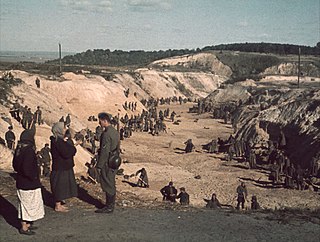 W
WBabi Yar is a ravine in the Ukrainian capital Kyiv and a site of massacres carried out by Nazi Germany's forces during its campaign against the Soviet Union in World War II. The first and best documented of the massacres took place on 29–30 September 1941, killing approximately 33,771 Jews. The decision to kill all the Jews in Kyiv was made by the military governor Generalmajor Kurt Eberhard, the Police Commander for Army Group South, SS-Obergruppenführer Friedrich Jeckeln, and the Einsatzgruppe C Commander Otto Rasch. Sonderkommando 4a as the sub-unit of Einsatzgruppe C, along with the aid of the SD and Order Police battalions with the Ukrainian Auxiliary Police backed by the Wehrmacht, carried out the orders. Sonderkommando 4a and the 45th Battalion of the German Order Police conducted the shootings. Servicemen of the 303rd Battalion of the German Order Police at this time guarded the outer perimeter of the execution site.
 W
WThe Bila Tserkva massacre was the World War II mass murder of Jews, committed by the Nazi German Einsatzgruppe with the aid of Ukrainian auxiliaries, in Bila Tserkva, Soviet Ukraine, on August 21–22, 1941. When the Jewish adult population of Bila Tserkva was killed, several functionaries complained that some 90 Jewish children were left behind in an abandoned building, and had to be executed separately. The soldiers reported the matter to four chaplains of the Wehrmacht, who passed along their protests to Field Marshal von Reichenau; it was the only time during World War II that Wehrmacht chaplains tried to prevent an Einsatzgruppen massacre, but Paul Blobel's verbal order was direct and decisive.
 W
WThe Battle of Brody was a tank battle fought between the 1st Panzer Group's III Army Corps and XLVIII Army Corps (Motorized) and five mechanized corps of the Soviet 5th Army and 6th Army in the triangle formed by the towns of Dubno, Lutsk and Brody between 23 and 30 June 1941. It is known in Soviet historiography as one of the "border defensive battles". Although the Red Army formations inflicted heavy losses on the German forces, they were outmanoeuvred and suffered enormous losses in tanks. Poor Soviet logistics, German air supremacy and a total breakdown in Red Army command and control ensured victory for the Wehrmacht despite overwhelming Red Army numerical and technological superiority.
 W
WThe act of restoration of the Ukrainian state or proclamation of the Ukrainian state of June 30, 1941 was announced by the Organization of Ukrainian Nationalists (OUN) under the leadership of Stepan Bandera, who declared an independent Ukrainian State in Lviv. The prime-minister was Yaroslav Stetsko, and the head of Council of Seniors was Kost Levitsky.
 W
WThe Kamianets-Podilskyi massacre was a World War II mass shooting of Jews carried out in the opening stages of Operation Barbarossa, by the German Police Battalion 320 along with Friedrich Jeckeln's Einsatzgruppen, the Hungarian soldiers, and the Ukrainian Auxiliary Police. The killings were conducted on August 27 and August 28, 1941, in the Soviet city of Kamianets-Podilskyi, occupied by German troops in the previous month on July 11, 1941. According to the Nazi German reports a total of 23,600 Jews were murdered, including 16,000 who had earlier been expelled from Hungary.
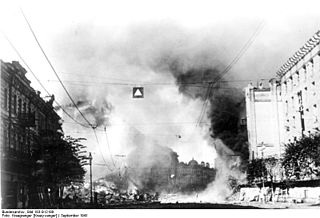 W
WThe First Battle of Kiev was the German name for the operation that resulted in a huge encirclement of Soviet troops in the vicinity of Kiev (Kyiv) during World War II. This encirclement is considered the largest encirclement in the history of warfare. The operation ran from 7 August to 26 September 1941 as part of Operation Barbarossa, the Axis invasion of the Soviet Union. In Soviet military history, it is referred to as the Kiev Strategic Defensive Operation, with the somewhat different dates of 7 July – 26 September 1941.
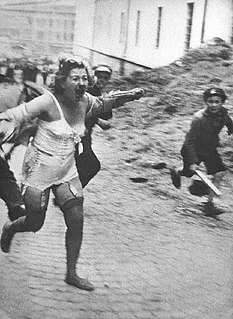 W
WThe Lviv pogroms were the consecutive pogroms and massacres of Jews in June and July 1941 in the city of Lwów in Eastern Poland/Western Ukraine. The massacres were perpetrated by Ukrainian nationalists, German death squads, and urban population from 30 June to 2 July, and from 25 to 29 July, during the German invasion of the Soviet Union. Thousands of Jews were killed both in the pogroms and in the Einsatzgruppen killings.
 W
WIn July 1941, 25 Polish academics from the city of Lwów along with their families were killed by Nazi German occupation forces. By targeting prominent citizens and intellectuals for elimination, the Nazis hoped to prevent anti-Nazi activity and to weaken the resolve of the Polish resistance movement. According to an eyewitness the executions were carried out by an Einsatzgruppe unit under the command of Karl Eberhard Schöngarth with the participation of Ukrainian translators in German uniforms.
 W
WOperation München was the Romanian codename of a joint German-Romanian offensive during the German invasion of the Soviet Union in World War II, with the primary objective of recapturing Bessarabia, Northern Bukovina and the Hertsa region, ceded by Romania to the Soviet Union a year before. The operation concluded successfully after 24 days of fighting. Axis formations involved included the Romanian Third and the Fourth Armies and the German Eleventh Army. The invasion was followed by a genocide against the Jewish population of Bessarabia.
 W
WThe siege of Odessa, known to the Soviets as the defence of Odessa, lasted from 8 August until 16 October 1941, during the early phase of Operation Barbarossa, the Axis invasion of the Soviet Union during World War II.
 W
WThe Odessa massacre was the mass murder of the Jewish population of Odessa and surrounding towns in the Transnistria Governorate during the autumn of 1941 and the winter of 1942 while it was under Romanian control.
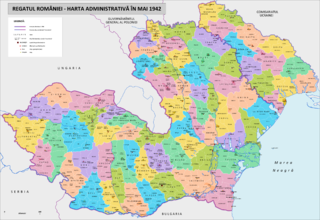 W
WThe Tighina Agreement was an agreement between Nazi Germany and Romania about administration, economy and security issues of the Transnistria Governorate that entered into force on 30 August 1941. It was signed during World War II, while the Axis invasion of the Soviet Union was taking place. The Tiraspol Agreement through which Romania received the region had entered in force shortly before, on 19 August.
 W
WThe Tiraspol Agreement was an agreement between Nazi Germany and Romania signed on 19 August 1941 in the city of Tiraspol regarding the Romanian administration of the region of Transnistria, which became the Transnistria Governorate. It fell under the rule of Gheorghe Alexianu, under immediate subordination of Ion Antonescu, the Conducător (leader) of Romania. It was signed during World War II, while the Axis invasion of the Soviet Union was taking place. The Tighina Agreement in which specific issues of the region were discussed entered in force shortly after, on 30 August. The agreement allowed full Romanian control over the territory between the Dniester and Southern Bug rivers, with the exception of the city of Odessa. The latter was ceded to Romania with some privileges for Germany in the Tighina Agreement.
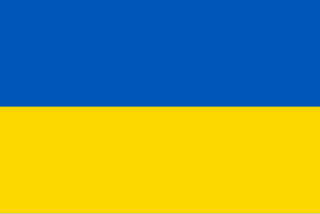 W
WThe Ukrainian national government of 1941 was a self-proclaimed Ukrainian government established on the Ukrainian territories occupied by Nazi Germany. The government was established by the 30 June 1941 Act of restoration of the Ukrainian state. It was led by the Stepan Bandera's faction of OUN.
 W
WThe Battle of Uman was the World War II German offensive in Uman, Ukraine against the 6th and 12th Soviet Armies. In a three-week period, the Wehrmacht encircled and annihilated the two Soviet armies